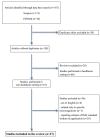Passive air sampling: the use of the index of microbial air contamination
- PMID: 32275273
- PMCID: PMC7975895
- DOI: 10.23750/abm.v91i3-S.9434
Passive air sampling: the use of the index of microbial air contamination
Abstract
Background: Bioaerosol plays an important role in human life with potentially infectious, allergic and toxic effects. Active and passive methods can be used to assess microbial air contamination, but so far there is not a unanimous consensus regarding the indications about methods to be used and how to interpret the results. The passive method has been standardized by the Index of Microbial Air contamination (IMA). Classes of contamination and maximum acceptable levels of IMA have been proposed, related to different infection or contamination risks. The aim of this study was to provide information about the use of the passive sampling method, with reference to the IMA standard.
Methods: We searched PubMed and Scopus for articles published until January 2020 reporting the citation of the article by Pasquarella et al. "The index of microbial air contamination. J Hosp Infect 2000". Only studies in English language where the IMA standard was applied were considered. Studies regarding healthcare settings were excluded.
Results: 27 studies were analyzed; 12 were performed in Europe, 8 in Asia, 5 in Africa, 2 in America. Cultural heritage sites, educational buildings and food industries were the most common indoor monitored environments; in 8 studies outdoor air was monitored.
Conclusions: This review has provided a picture of the application of standard IMA in different geographic areas and different environments at risk of airborne infection/contamination. The analysis of the results obtained, together with a wider collection of data, will provide a useful contribution towards the definition of reference limits for the various types of environments to implement targeted preventive measures.
Conflict of interest statement
Each author declares that he or she has no commercial associations (e.g. consultancies, stock ownership, equity interest, patent/licensing arrangement etc.) that might pose a conflict of interest in connection with the submitted article
Figures
References
-
- Douwes J, Thorne P, Pearce N, Heederik D. Bioaerosols health effects and exposure assessment: progress and perspectives. Ann Occup Hyg. 2003;47(3):187–200. - PubMed
-
- Mandrioli P, Caneva G, Sabbioni C. Cultural heritage and aerobiology. Methods and measurement techniques for biodeterioration monitoring. Kluver, Dordrecht. 2003
Publication types
MeSH terms
LinkOut - more resources
Full Text Sources


